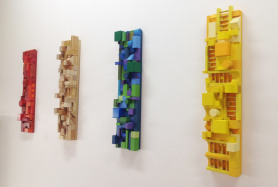Site Seeing, my exhibition at AirSpace Projects last month turned out to be highly topical, focussing on cities – the good, the bad and the ugly. The works were constructed from found, toy-building blocks and sampled fragments of film. They are impressions of cities, their romantic, nightly, filmic spectacle and their mortgage belts and housing bubbles.
 Cinema Città 3, 2016 Digitally printed acrylic and recycled UV stabilised polymer, warm white LED.
Cinema Città 3, 2016 Digitally printed acrylic and recycled UV stabilised polymer, warm white LED.
Growing up in Canberra, a model city, you cannot help but be aware of the politics of cities and the conflict between private and public space.
Architecture it is said, ‘is the most political of all the art forms’.
Canberra is synonymous with architecture and politics and is frequently described as lacking a heart and soul.
I am fascinated by the shared metaphors of bodies and cities, their bypasses and arterial roads. You can trace these metaphors back to William Harvey’s dangerous discovery in 1628, that it is the heart, which functions to circulate the blood and not the soul. Interestingly, Christopher Wren, the famous English architect did many of the drawings for Harvey’s publication, De Motu Cordis, Concerning the Motion of the Heart and Blood.
If you peel back the skin of the city the structure of the grid is revealed. The grid structure has fleshed out human achievement through time and space; from the brick to the tablet, longitude to the World Wide Web and typeface to cloud space.
 Corporate Body series, found building blocks and acrylic paint on multi-panel, 600 x 135x 70mm
Corporate Body series, found building blocks and acrylic paint on multi-panel, 600 x 135x 70mm
I have always been interested in Constructivism and its relationship to architecture and design. The Constructivists tried to create works that would make the viewer an active participant – art for social purpose.
But Constructivism is also a learning theory. This theory states that we make meaning as humans from our experiences. In that context we could all be said to be, site-specific public artworks, trying to find our unique characteristics and the means to share them.
 Urban form, 2016 Found building blocks and acrylic paint on multi-panel, 620 x140 x 70mm
Urban form, 2016 Found building blocks and acrylic paint on multi-panel, 620 x140 x 70mm
The exhibition and my residency in Ashfield posed the question, how can we value and share what is special about the places we live in?
A necessary question if we are to avoiding cities as Gertrude Stein quipped (when describing Los Angeles), ‘that when you get there, there is no there, there’.
By 2050, 75% of the world’s population will be living in cities. As Paolo Baratta, President of la Biennale Architettura di Venezia 2016 describes, ‘much of this immense swathe of human habitation no human could be proud of’.
But cities exist as a function of the circulation of people and the circuitry of information. Probing the question, can we create a model of the city in which we as dwellers can influence its values as well as its forms?

Leave a Comment